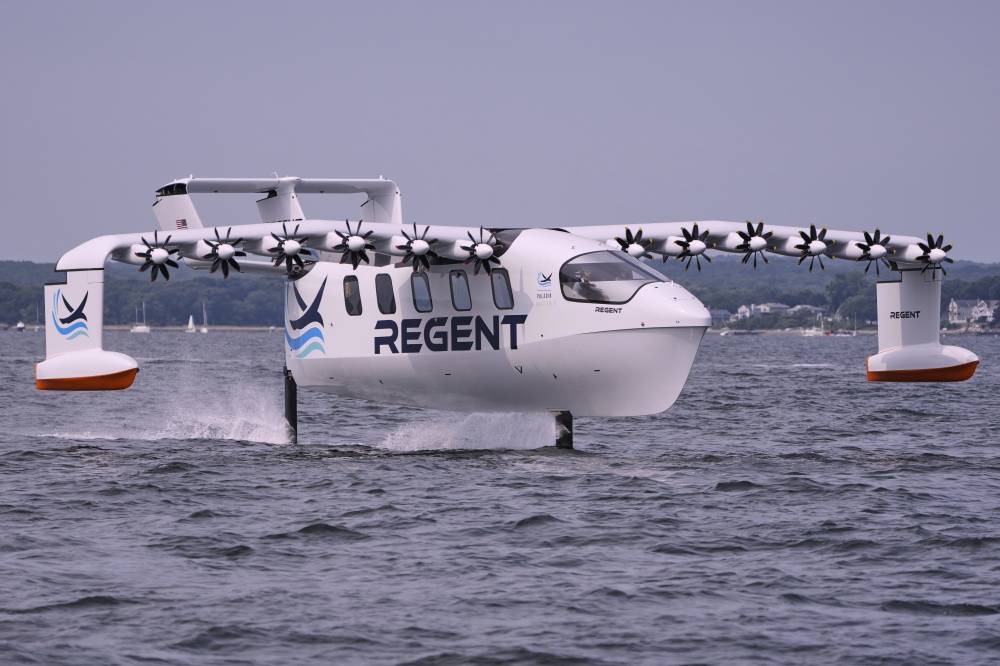Winged ferry that floats and flies like a pelican

NORTH KINGSTOWN, RHODE ISLAND—The winged passenger ferry gliding over the surface of Narragansett Bay could be a new method of coastal transportation or a new kind of warship.
Its maker, Regent Craft, is betting on both.
Twelve quietly buzzing propellers line the 20-meter (65-foot) wingspan of Paladin, a sleek ship with an airplane’s nose. It looks nothing like the sailboats and fishing trawlers it speeds past through New England’s largest estuary.
“We had this vision five years ago for a seaglider—something that is as fast as an aircraft and as easy to drive as a boat,” said CEO Billy Thalheimer.
On a cloudy August morning, Thalheimer sat in the Paladin’s cockpit and, for the first time, took control of his company’s prototype craft to test its hydrofoils. The electric-powered watercraft has three modes—float, foil and fly.
50 mph
From the dock, it sets off like any motorized boat. Farther away from land, it rises up on hydrofoils—the same kind used by sailing ships that compete in America’s Cup. The foils enable it to travel more than 80 kilometers (50 miles) per hour—and about a person’s height—above the bay.
What makes this vessel so unusual is that it’s designed to soar about 10 meters (30 feet) above the water at up to 290 km (180 miles) per hour—a feat that hasn’t quite happened yet, with the first trial flights off Rhode Island’s seacoast planned for the end of summer or early fall.
If successful, the Paladin will coast on a cushion of air over Rhode Island Sound, lifting with the same “ground effect” that pelicans, cormorants and other birds use to conserve energy as they swiftly glide over the sea. It could zoom to New York City, which takes at least three hours by train and longer on traffic-clogged freeways, in just an hour.
As it works to prove its seaworthiness to the US Coast Guard and other regulators around the world, Regent is already lining up future customers for commercial ferry routes around Florida, Hawaii, Japan and the Persian Gulf.
Regent is also working with the US Marines to repurpose the same vessels for island-hopping troops in the Pacific. Those vessels would likely trade electric battery power for jet fuel to cover longer journeys.
1930s era
With backing from influential investors including Peter Thiel and Mark Cuban, Thalheimer says he’s trying to use new technology to revive the “comfort and refined nature” of 1930s-era flying boats that were popular in aviation’s golden age before they were eclipsed by commercial airlines.
This time, Thalheimer added, they’re safer, quieter and emission-free.
Cofounders and friends Thalheimer, a skilled sailor, and chief technology officer Mike Klinker, met while both were freshmen at the Massachusetts Institute of Technology and later worked together at Boeing. They started Regent in 2020.
They’ve already tested and flown a smaller model. But the much bigger, 12-passenger Paladin—prototype of a product line called Viceroy—began foil testing this summer after years of engineering research and development. A manufacturing facility is under construction nearby, with the vessels set to carry passengers by 2027.
Ships, not aircraft
The International Maritime Organization (IMO) classifies “wing-in-ground-effect” vehicles such as Regent’s as ships, not aircraft. But a database of civilian ships kept by the London-based organization lists only six around the world, all of them built before it issued new safety guidance on such craft in 2018 following revisions sought by China, France and Russia.
The IMO says it treats them as marine vessels because they operate in the vicinity of other watercraft and must use the same rules for avoiding collisions. The Coast Guard takes a similar approach.
One of the biggest technical challenges in Regent’s design is the shift from foiling to flying. Hydrofoils are fast for a seafaring vessel, but far slower than the speeds needed to lift a conventional airplane from a runway.
That’s where air blown by the 12 propellers comes in, effectively tricking the wing into generating high lift at low speeds.
All of this has worked perfectly on the computer simulations at Regent’s headquarters in North Kingstown, Rhode Island.
The next step is testing it over the water.

















